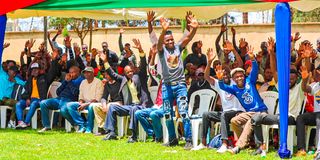How India turned teenage boys into powerful gender allies

Young men gather at the Kiambu County headquarters during the historic launch of Boychild Day on April 5, 2024. The initiative aims to empower boys and young men across the county through annual celebrations and targeted programs. A Unesco study uncovers successful strategies in engaging men for social change.
What you need to know:
- A Unesco report reveals groundbreaking insights from India, where programs targeting males aged 13-25 have successfully transformed them from mere recipients of gender equality information into active change agents.
- The initiatives achieved success through strategies such as creating safe spaces for masculine vulnerability, leveraging men's concerns, and implementing six-month cyclical engagement programs.
- Key outcomes included increased contraceptive use, improved attitudes towards girls' education, better spousal communication, and the prevention of child marriages.
It is now accepted globally that engaging men and boys towards gender equality is imperative. This movement gained traction in the late 1990s and has taken different shapes in various parts of the world. But what lessons arise from the initiative? This is the gist of the 2024 Unesco publication Engaging men and boys: A report on pathways to gender equality, which catalogues experiences from India. These insights are not only intrinsically useful, they are also important for comparing experiences from different regions hence distilling universals and divergences.
The ten case studies featured are based on three programmatic areas namely gender-based violence (GBV), family planning and nutrition, targeting men and boys aged 13 to 25. The engagement of boys and men was justified by the facts that they are the primary decision makers in families (hence influence social outcomes at that level) and are the majority perpetrators of or bystanders on GBV. In addition, evidence suggests that their involvement makes a positive difference towards gender equality.
The program evolved from targeting them as mere recipients of information and awareness on gender equality to transforming them into change agents carrying out peer education and replicating the efforts in different community contexts. The key intervention models were: gender-integrated life skills training through formal school curricula; social and behaviour change communication activities; and knowledge and attitudinal change processes.
The interventions also used the ecological model developed by Urie Bronfenbrenner in the 1970s. The framework looks at variables at individual, community, institutional and policy levels, and is applied to identify and scale interventions appropriately.
Productive families
A number of key outcomes were realised. One, the commitment of boys and men towards gender equality was realised through capacity building. Two, treating men and boys not only as change agents but also as beneficiaries of gender equality endeared them to the quest. For instance, they realised that eradicating GBV results in more peaceful, cohesive and productive families to the benefit of everyone including themselves.
Three, by mentoring their peers, the transformed men and boys created a radial effect which extended the campaign beyond where it began to larger audiences. This gave the men and boys satisfaction from seeing their actions changing families and communities hence, energised them to do more.
Economic providers
To reinforce this, the program used a cyclical and iterative process where participants were engaged for just about six months before moving to another set. Four, the program leveraged issues that resonated with men and boys, such as the pressures they faced as economic providers and financiers of family health and nutrition. Association with these issues made the programme immediately and practically relevant to them hence stimulated and sustained their involvement.
Five, creating safe spaces where men and boys could talk to one another about masculinities and their own vulnerabilities made them feel less threatened about the eventual outcomes of their engagement and dispelled latent fears.
Most of the programs focused on single sectors for pragmatic reasons while a few engaged multiple areas of work. They also had intersectional ingredients which dealt with sites of exclusion such as caste, class, age, religion and sexual identity. One constraint was that most of the programs had short lifespans of 2-3 years, consonant with donor funding cycles, with only a few lasting 6-10 years. However, their sustainability was enhanced by acceptance by the government and popularity in communities.
Documented benefits for women and girls included: increased use of contraceptives; positive changes in attitudes and behaviours towards girls’ education, women’s mobility, work and fertility; and increase in spousal communication and support.
For men, benefits covered changes in attitudes around violence, gender division of labour, safe sex practices, girls’ education and fertility. Families and communities benefited from increased awareness about contraceptives and family planning, positive changes in men’s attitudes about norms related to fasting, menstrual taboos and child marriage, increase in immunisation rates and prevention of child marriages.
The publication documents key success factors in engaging men and boys in gender transformative work. These include: using a human rights approach; recognising men and boys as beneficiaries and agents of change; avoidance of demonising and profiling them as perpetrators; stimulating their positive agency for change; promotion of respectful, dialogical and responsible relationships; identifying and amplifying the personal and professional benefits of gender equality; cultural sensitivity; creation of safe spaces for discussions on intimate issues; inclusion of intersectional themes; leveraging interpersonal support; discussion of positive coping mechanisms to manage societal pressures around masculinities; using participatory activities; inter-gender interactions; and technical grounding on gender power dynamics.
But does this mean that engaging men and boys is plain sailing and without challenges? Far from it. Story for another day.
The writer is a lecturer in Gender and Development Studies at South Eastern Kenya ([email protected]).


